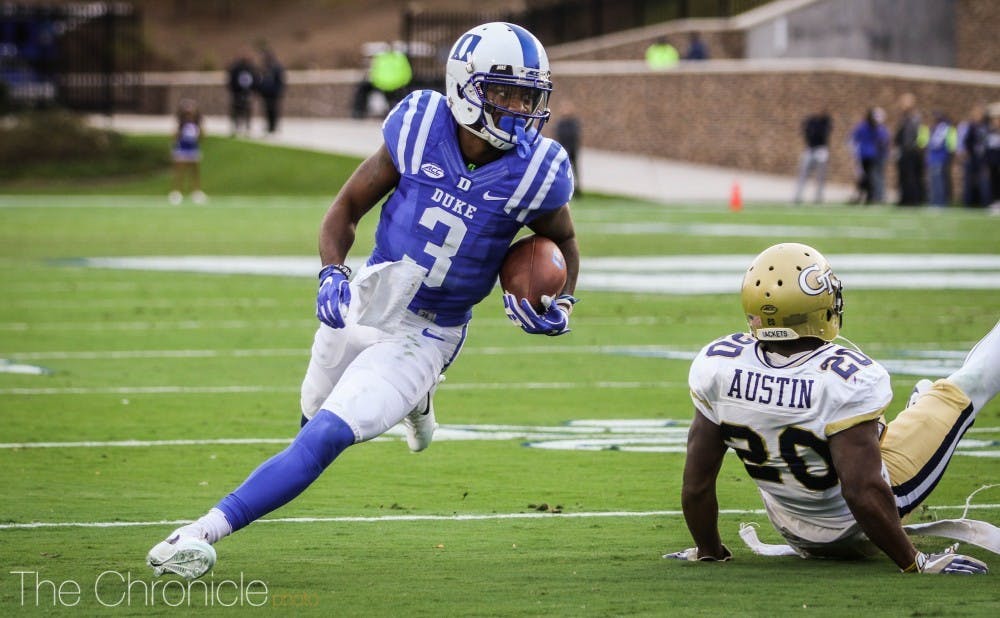As T.J. Rahming celebrated in the end zone last December in Detroit, one could see relief on the wideout’s face.
It was an easy reception, something that came often for Rahming last season—the Blue Devils’ top receiver caught nearly twice as many passes as any other player, but he snagged just two touchdowns. As a whole, Duke’s deep passing game floundered, ranking 79th out of 129 FBS teams with an average of 10.4 yards per completion.
Quarterback Daniel Jones said a year ago that his offense, and passing game in particular, had a chance to be both “dynamic” and “explosive.” The results, however, painted a far different picture in 2017.
“It’s certainly an exciting position to be in as a quarterback with the receivers we have coming back and a lot of the same faces in the same positions,” Jones said at ACC Media Days in July. “Growing with those guys, we’ve been able to take the next step with a lot of them. And older guys that kind of know what’s going on and know what we expect have made it easier for the younger guys to step in and get going.”
Youth is going to be key for these Blue Devils. 2018 will be the final season for three of Duke’s top four receivers—Rahming, Johnathan Lloyd and Chris Taylor—as well as tight ends Daniel Helm and Davis Koppenhaver.
But the Blue Devils are loaded with pass-catching options, some of whom have yet to see the field in Durham.
There’s freshman wide receiver Jake Bobo, who head coach David Cutcliffe described as having “a gift for catching contested passes” at 6-foot-4. Sophomore Noah Gray caught two touchdowns last season—as many as the entire Duke wide-receiving corps beyond Rahming—and leads a trio of young tight ends with Jake Marwede and Mark Birmingham.
And yet, none of them may be as intriguing in the Blue Devil passing game as a running back.
“You can’t keep Deon [Jackson] off the field,” head coach David Cutcliffe said in mid-August. “We’re putting both [Brittain Brown and Jackson] on the field at the same time, using Jackson in a lot of places.”
Jackson, a consensus three-star recruit out of Atlanta’s Pace Academy, originally split time between receiver and back during his sophomore season of high school before transitioning fully to the running back spot as a junior. He rushed for nearly 1,600 yards that year and was ranked as one of the nation’s top 60 running backs in the class of 2016.
As a true freshman in 2017, Jackson saw the field for just 129 snaps—he played mostly special teams, getting 35 total touches for the Duke offense. But with Shaun Wilson graduated, Jackson seems poised to have a big role in his second season.
“Having a history at wide receiver just helps me a lot with route-running, understanding coverages and reading DBs,” Jackson said. “I’m pretty comfortable wherever the coaches put me.”
Rahming is the only pass-catcher that has consistently performed for the Blue Devils over the course of multiple seasons, but Cutcliffe hopes they’ll be able to find a little more balance in 2018 and take advantage of depth across the offense.
“We’re using a lot of different personnel groupings which helps, not to trick or confuse opponents, but to utilize the different guys we have,” Cutcliffe said. “[Deon] gives us an opportunity...to do a few more unique things with our backs.”
Varied personnel groups aren’t necessarily new for Duke—four tight ends played in every game last season for the Blue Devils.
What is changing, though, is their usage levels in the pro game.
All multiple tight-end sets (with either one or two running backs) in the NFL increased by more than 1 percent from 2016 to 2017. The same can be said for groupings with two running backs, whereas sets with either three or four wide receivers declined.
Still, 11 personnel (one tight end, one running back, three wide receivers) was by far the dominant grouping in 2017, accounting for nearly 60 percent of NFL plays.
Last season, Duke’s top four receivers combined for 145 catches on 252 targets, averaging 6.8 yards per target with five touchdowns. The tight-end trio of Helm, Koppenhaver and Gray was much more efficient, not only catching 44 of its 63 targets, but also averaging 7.2 yards per target with seven scores.
All of this isn’t to say that the Blue Devils won’t lean on their receivers for explosive plays. Duke ranked right in the middle of the pack in terms of offensive efficiency last year, and it will need guys like Rahming to help elevate Jones.
With depth in his pass-catching arsenal, Jones could finally put together a complete season with the help of some soon-to-be-known names.
“We have a multitude of weapons all over the field,” Jones said. “That’s exciting as an offense, just how many different ways we can throw the football, and we’ll continue to grow with that throughout the season.”
Get The Chronicle straight to your inbox
Signup for our weekly newsletter. Cancel at any time.
Twitter: @mpgladstone13
A junior from just outside Philadelphia, Mitchell is probably reminding you how the Eagles won the Super Bowl this year and that the Phillies are definitely on the rebound. Outside of The Chronicle, he majors in Economics, minors in Statistics and is working toward the PJMS certificate, in addition to playing trombone in the Duke University Marching Band. And if you're getting him a sandwich with beef and cheese outside the state of Pennsylvania, you best not call it a "Philly cheesesteak."

